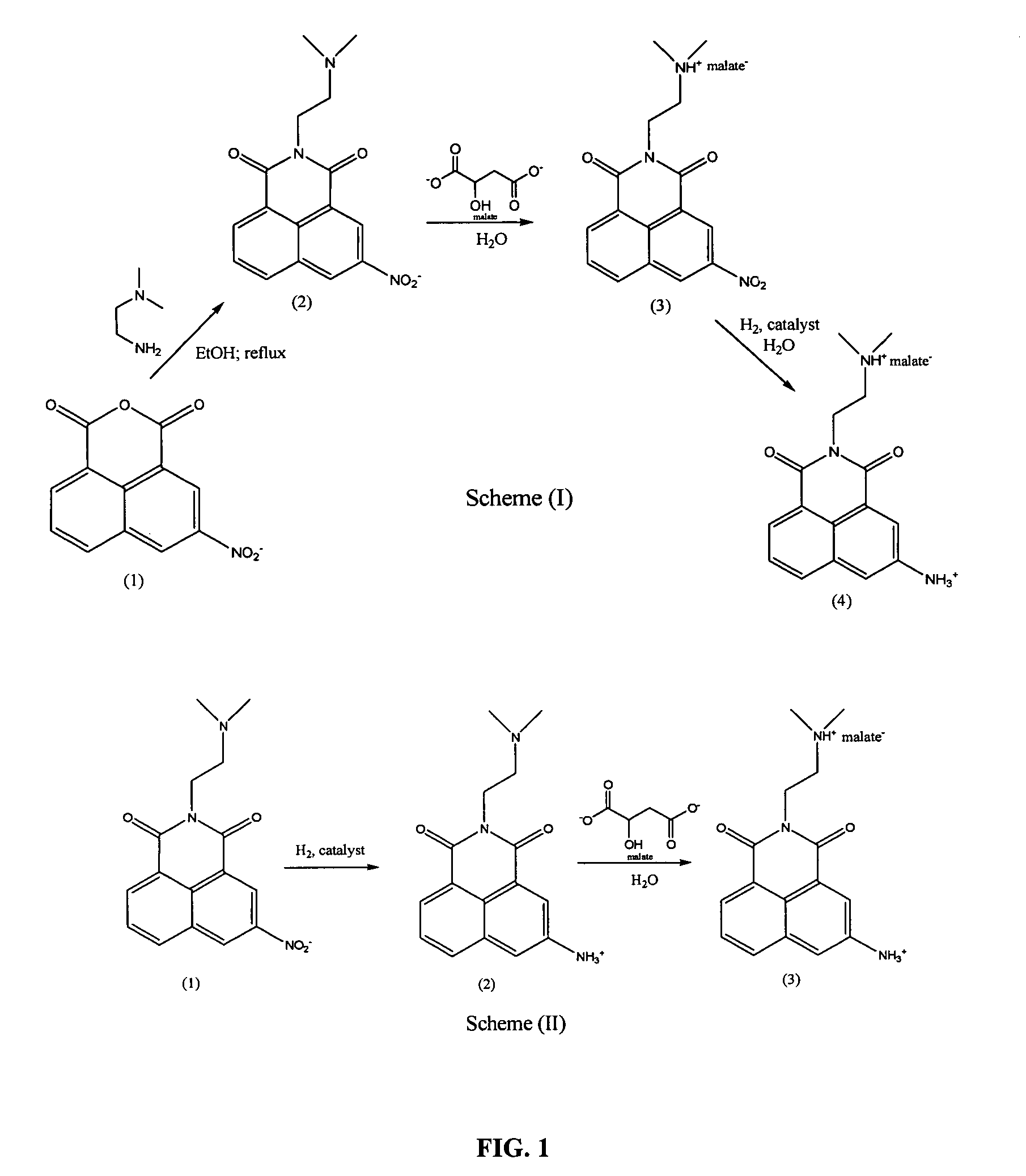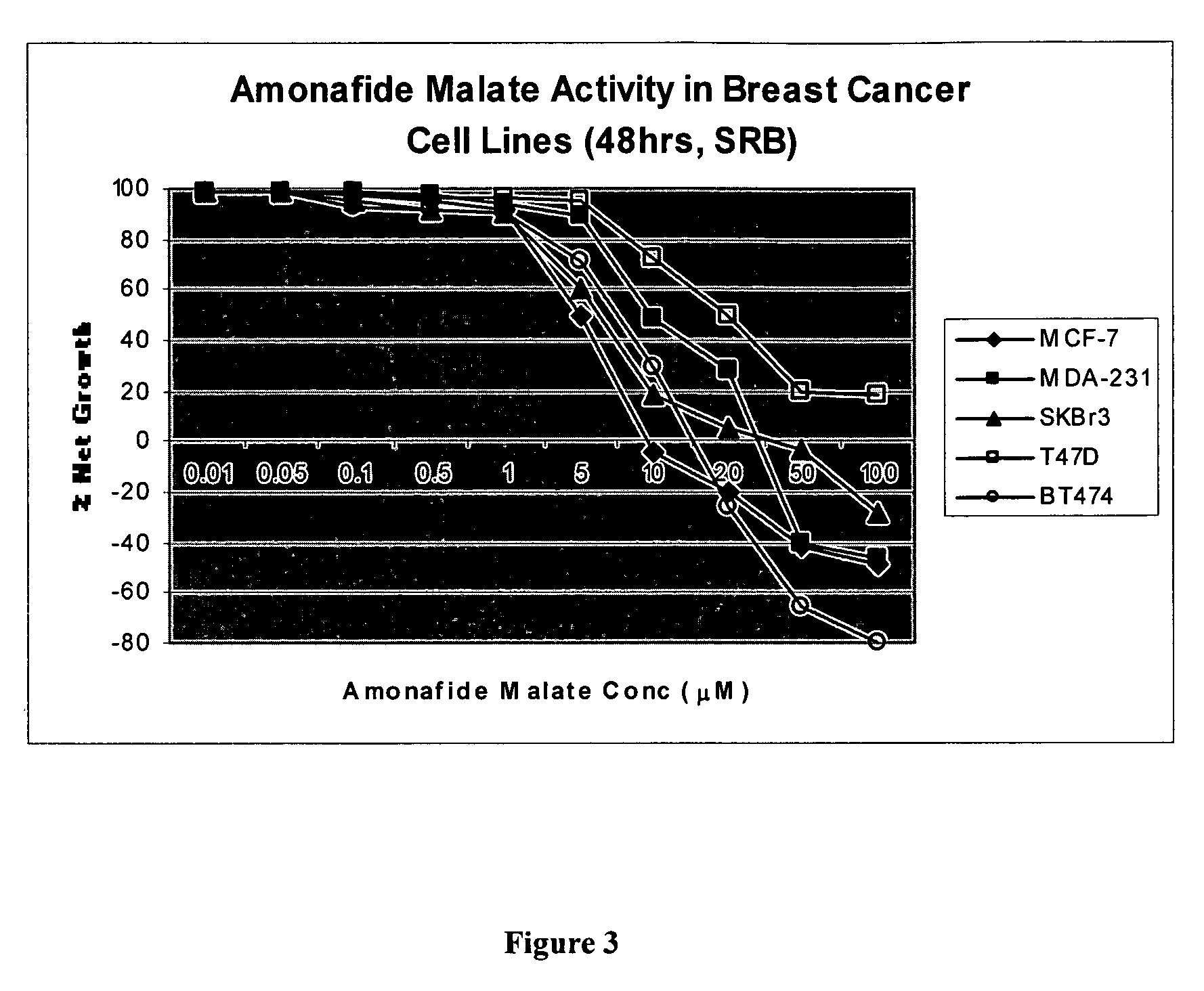Amonafide salts
a technology of amonafide salt and amonafide salt, which is applied in the field of amonafide salts, can solve the problems of reducing the net yield of materials to 30%, incompatible divalent species, and hydrate formation, and achieves the effects of reducing hygroscopicity, facilitating bulk processing, and reducing hygroscopicity
- Summary
- Abstract
- Description
- Claims
- Application Information
AI Technical Summary
Benefits of technology
Problems solved by technology
Method used
Image
Examples
example 1
Direct Synthesis of Intercalator Drug Amonifide as an Organic Acid (L-malate) Salt by the Method of the Present Invention
[0066] 1. Preparation of mitonafide malate (III, FW 447.42)
[0067] Referring to FIG. 1, preparation of mitonafide malate (3) was carried out according to Scheme (I).
Reactants:
[0068] (A) 3-nitro-1,8-nitronaphthalic anhydride, (FW 243.18, CAS 3027-38-1, purity 99%, ACROS, cat. # 27873-0250);
[0069] (B) N,N-dimethylethylenediamine (FW 88.15, CAS 108-00-9, purity 99%, ACROS cat. # 11620-100);
[0070] (C) L-malic acid (FW 134.09, CAS 97-67-6, purity 99% ACROS cat. # 15059-1000
Synthetic Procedure:
[0071] 100 gr. (0.41 mol, 1 eq.) of the anhydride (A) were combined with 1300 ml of anhydrous ethanol in a 3 L 3-neck round bottom flask fitted with an adding funnel and mechanical paddle stirrer. While vigorously stirring the suspension, a solution of 40 gr (0.45 mol, 1.1 eq.) of the diamine (B) in 100 ml of anhydrous ethanol was added as a rapid drip. Stirring was conti...
example 2
Synthesis of Amonifide Organic Carboxylic Acid Salts by Titration According to the Method of U.S. Pat. No 5,183,821
[0083] A panel of salts were readily prepared in semi-automated fashion. It should be understood that any analog or congener thereof, with similar aralkylamine derived basicity properties, would be equally suitable as an exemplar.
[0084] Scheme (II), FIG. 1, illustrates the conceptual steps of amonafide salt synthesis in this example.
[0085] Referring to Scheme (II), a stock solution of amonafide free base (2) was first dispensed into individual reaction vials so as to provide a defined amount of basic substrate. It was then titrated with a second solution containing one stoichiometric equivalent of an appropriate organic carboxylic acid, whose acidity is consistent with an aqueous pKa value of not less than 3. The resulting mixture was warmed in order to effect complete dissolution and neutralization of the species reacting ionically, and allowed to deposit the result...
example 3
Organic Salts of Amonifide are More Readily Purified than HCl or Methanesulfonic Acid Salts of Amonifide Independent of Method of Synthesis
[0091] I. Direct Synthesis Amonafide Monohydrochloride Salt by the Method of Example 1 [0092] 1. Preparation of mitonafide monohydrochloride (FW 349.82)
[0093] Referring to FIG. 1, preparation of mitonafide monohydrochloride (3) was carried out according to Scheme (I).
Reactants:
[0094] (A) 3-nitro-1,8-nitronaphthalic anhydride, (FW 243.18, CAS 3027-38-1, purity 99%, ACROS, cat. # 27873-0250);
[0095] (B) N,N-dimethylethylenediamine (FW 88.15, CAS 108-00-9, purity 99%, ACROS cat. # 11620-100);
[0096] (C) 6.0 N Hydrochloric acid (FW 36.45 CAS 7647-01-0, purity 99.9% ACROS cat. # 61327-0010
Synthetic Procedure:
[0097] 10 gr. (0.041 mol, 1 eq.) of the anhydride (A) were combined with 130 ml of anhydrous ethanol in a 0.3L 3-neck round bottom flask fitted with an adding funnel and mechanical paddle stirrer. While vigorously stirring the suspension, ...
PUM
| Property | Measurement | Unit |
|---|---|---|
| organic | aaaaa | aaaaa |
| pharmaceutical composition | aaaaa | aaaaa |
| organic hydroxy acid | aaaaa | aaaaa |
Abstract
Description
Claims
Application Information
 Login to view more
Login to view more - R&D Engineer
- R&D Manager
- IP Professional
- Industry Leading Data Capabilities
- Powerful AI technology
- Patent DNA Extraction
Browse by: Latest US Patents, China's latest patents, Technical Efficacy Thesaurus, Application Domain, Technology Topic.
© 2024 PatSnap. All rights reserved.Legal|Privacy policy|Modern Slavery Act Transparency Statement|Sitemap



